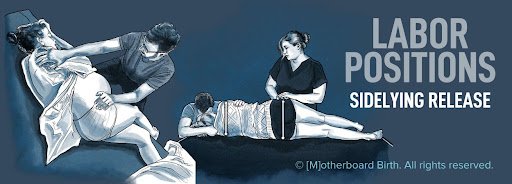The Best Labor Positions for a More Comfortable Birth (2024)
What we’ll cover in this post:
Best Labor Positions for a More Comfortable Birth
While in labor and while giving birth, it’s important to remember that gravity is your friend!
Different positions and frequent movement/position changes can really help your baby engage into your pelvis and get into an optimal birthing position.
Keep in mind that the best way to get through labor and the best way to give birth is whatever way you are most comfortable.
Let’s talk about some different labor positions for a more comfortable birth and maybe even a shorter labor!
Benefits of moving around during labor
Moving around during labor can not only help to speed up the labor process, but staying active and upright can also ensure that your baby has the help of gravity to engage into an optimal birth position.
The most ideal birth position is where baby is head down, chin tucked, and facing your spine, like this:
When your baby faces your belly, it can cause uncomfortable and long back labor.
Being able to move freely throughout labor allows you to find whatever position is most comfortable, especially while working through contractions. Utilizing these positions and finding what feels best for you can help decrease the overall pain associated with labor and contractions.
What positions help start labor
If you’re at the end of your pregnancy and feeling eager for your baby to make an appearance, you may be wondering if there are any positions that can help to jump start labor.
Basically, any position that encourages your baby to engage and rotate into your pelvis is going to be beneficial. Mix it up often so baby has opportunities to find the easiest path!
Bouncing on an exercise ball
Gently bouncing on an exercise ball with your legs wide apart can not only help with cervical dilation, but this position can also help encourage your baby to move down and engage into your pelvis.
Curb walking
Curb walking is walking with one foot on top of the curb/sidewalk and the other foot on the road. This may feel a little awkward, but the uneven shift in your weight is what may help to bring on labor.
Curb walking allows gravity to encourage your baby to drop into your pelvis, which, in turn, can help dilate your cervix.
Supported squat
Sitting in a supported squat position really allows gravity to assist the baby into an optimal position. It’s best to do this with the help of a partner/friend or to use a wall for support, since being pregnant can affect your balance.
Try to achieve a deep squat with your legs in a “V” position. This position can really help to open up your pelvis, move your baby down, which can also help to dilate your cervix.
What positions help you dilate?
Most positions that use gravity to help move the baby down can also help to dilate your cervix, but there are some positions that can specifically encourage cervical dilation.
Asymmetric positions
Asymmetric positions, like curb walking, help to dilate the cervix because you are wiggling your pelvis in ways that it’s not typically used to going. This can help your baby find new pathways down and out.
If you are unable to curb walk, you can achieve the same asymmetry by wearing one heel and one flat shoe or walking up and down stairs.
Some other asymmetric positions include:
Lunges
Captain morgan
Toilet lunges
Sitting on the toilet
Sitting on the toilet allows you to be in that “supported squat” position we talked about.
Typically, when we sit on the toilet, we are using the bathroom; so, naturally, we are accustomed to relaxing our pelvic floor while sitting on the toilet.
A relaxed pelvic floor in combination with a supported squat can really help put that needed pressure on your cervix to help encourage dilation.
Side-lying release
Explaining the side-lying release (SLR) position/maneuver may seem a little cumbersome, so it’s best to check out some photos/a great explanation here.
The side-lying release (SLR) position temporarily allows some extra room in the pelvis. This is especially beneficial if you’re wanting the baby to turn/reposition themself.
Not only can this position be used to help engage the baby into the pelvis and to encourage cervical dilation, but it can also be used during labor to help ease discomfort.
You will need another person to help assist with the side-lying release (SLR) maneuver.
What positions help a stalled labor?
If your labor has already started and now it is “stalled”, it can be pretty frustrating.
One of the most common reasons for a stalled labor is an environmental change, like leaving your home to get to the hospital/birthing center.
This is your body’s natural defense mechanism, wondering “Are we comfortable?” “Are we safe?”
Once you are settled and comfortable, you can try some positions to get labor started back up again. In this instance, you definitely want to keep moving!
Any upright position
Just simply walking or standing/swaying can help to restart a stalled labor. The goal is to use gravity to help move the baby down and put some pressure on your cervix.
Remember, gravity is your friend!
Any active position
Staying upright and active to help restart labor is key!
Some active positions you can try include:
Curb walking/walking stairs
Walking
Dancing
Dangling (with the support of a birth partner)
Squatting (supported and/or hanging)
Leaning (into a wall, over the side of the bed, etc.)
Standing/swaying
Hands and knees
Nipple stimulation
While this isn’t necessarily considered a “position”, nipple stimulation can be used to induce labor. Nipple stimulation causes a release of oxytocin, which causes uterine contractions. If it works to help induce labor, it can also work to help restart a stalled labor.
This can be done with a pump, with your hands, or with the help of a partner, just make sure to check in with your midwife or doctor if it’s appropriate to pump based on your medical history. If your baby’s heart rate is stressed they may discourage it.
Which position is best to cope with labor pains?
It’s no secret that labor can be painful. Some people prefer to avoid the term “pain” and refer to contractions as “waves” or “intensity”. Either way, there are ways to cope with the contractions.
First, try to keep in mind that contractions are, in fact, waves of intensity. Most of the time, you are going to get a short break between contractions. Try your best to keep your eye on the prize, AKA the break!
*A doula can be very helpful in keeping your eye on the prize. Check out our blog post to see if hiring a doula is the right idea for you!
The best positions you can use to help cope with labor pains are whichever positions feel most comfortable for you.
It may be comfortable for you to use a ball, to stay upright, to sit on the toilet, to lean over a bed or into a birth partner or you may prefer that someone applies some pressure to your back/hips during contractions; coping with the pain is completely individualized.
Having someone, like a doula, to help coach you into different positions may help you find what is most comfortable for you sooner than later.
Which positions are good for long labors?
Having a long labor can be pretty defeating, especially if you feel like you’re working hard.
It’s important to find a nice balance between being active and resting while you can.
Some positions that can still help to keep your pelvis open and baby engaged, while allowing some rest include:
Side lying with a peanut ball
Leaning into a partner or a bed
Sitting/swaying on a ball with your head resting on a bed
Frog seated
Which positions can you labor and give birth in with an epidural?
Just because you choose to get an epidural, does not mean you are stuck laying in a bed for the duration of your labor/birth.
A “walking epidural” is an option; this is a “mild” epidural that still allows you to freely move while taking the edge off. With a walking epidural, you are able to get into almost any position that is comfortable for you.
If you are getting a standard epidural, it’s pretty common for you to be numb from the waist down. You are still able to get into another position, you just may need some help.
Some positions that you can be assisted into with an epidural include:
Side lying with or without a peanut ball
Sitting upright (with the help of pillows or sitting head of bed up)
Leaning over the head of the bed
Knees to chest
Squatting with the help of a squat bar
Using a rebozo (Mexican scarf) or sheet to play “tug of war”
Things that limit movement
If you labor and give birth in a hospital, there are some things that may limit your movement.
We discuss all of these options and their pros/cons over on our Birth App!
Want to stay active in labor and birth? Add your preferences on freedom of movement and birthing in whatever position is comfortable for you on our Birth Plan Web App!
How often should you change positions?
To keep labor moving, open, and active, changing positions every 30-60 minutes is optimal.
Be sure to find a good balance between resting and staying active, especially if you are experiencing a longer labor.
Are there risks to any labor positions?
Unless your provider specifically tells you to avoid a position due to a health/medical concern, no labor positions are off limits.
Your nurse/provider will monitor your baby, either continuously or intermittently, during labor. If your baby is having some unpleasant heart rate changes while in a certain position, just change to another position that makes baby happy!
The Takeaway
Finding out how to make labor and birth more comfortable may be a little tricky, but it’s important to know that there are a ton of positions that can make contractions more bearable.
Learning about these positions prior to labor may help you to feel more in control when it’s time. Also, having the help of a doula, a trained birth professional, can totally take this part out of your hands. A doula can easily guide you into different positions to ensure you are most comfortable.
You may find that laboring on your hands and knees is most comfortable or that giving birth standing up feels the best.
Take a look over the best labor positions for a more comfortable birth and keep them in mind toward the end of your pregnancy!
🤍 The Motherboard Team














